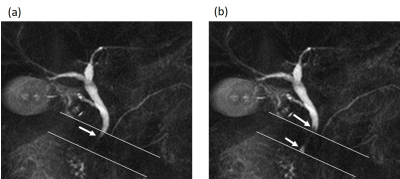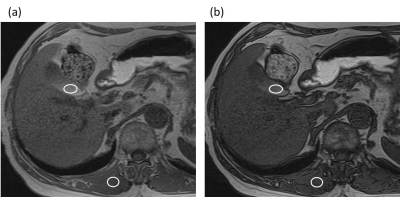4219
Bile flow dynamics in patients with cholelithiasis: Evaluation with cine-dynamic MRCP using spatially selective inversion-recovery pulse1Radiology, Yamaguchi University Graduate School of Medicine, Ube, Yamaguchi, Japan
Synopsis
We evaluated the changes in the bile flow dynamics in patients with cholelithiasis using cine-dynamic MRCP with a spatially selective IR pulse. The frequency and mean secretion grade of the antegrade bile flow were significantly increased in the gallstone group than in the non-gallstone group, while no significant differences in the frequency and mean secretion grade of the reverse bile flow were found between the two groups. Cine-dynamic MRCP with a spatially selective IR pulse can visualize the changes in the bile flow dynamics in patients with gallstones noninvasively.
Introduction
In patients with cholelithiasis, a variety of pathophysiological changes in the biliary system have been reported. Gallbladder function such as filling and emptying could be impaired in patients with cholelithiasis probably due to increased cystic duct resistance 1. A recent study showed that the common bile duct pressure in patients with gallstones was significantly higher compared to patients without gallstones 2. Another study also indicated that the accumulation of bile in the gallbladder was delayed in association with gallstones, suggesting the increased internal pressure in the gallbladder 3. These changes in the physiological and pathological functions of the biliary system can affect the bile flow dynamics. Although recognition of bile flow dynamics in patients with gallstones might play an important role in understanding the pathogenesis of cholelithiasis and in determining appropriate patient management, the changes in the bile flow dynamics in patients with cholelithiasis remain unclear. Cine-dynamic magnetic resonance cholangiopancreatography (MRCP) with a spatially selective inversion recovery (IR) pulse can directly and noninvasively visualize the physiological flow of bile 4. Using this technique, some studies have evaluated the flow dynamic pattern of bile in a variety of pathological conditions such as extrahepatic bile duct dilatation and post-cholecystectomy 4, 5. The purpose of this study was to elucidate the changes in the bile flow dynamics in patients with cholelithiasis using cine-dynamic MRCP with a spatially selective IR pulse.Methods
This retrospective study included 25 patients with gallstones (gallstone group) and 69 patients without gallstones (non-gallstone group) who underwent upper abdominal MR imaging including T1-weighted gradient echo in- and opposed-phase images and cine-dynamic MRCP with a spatially selective IR pulse between January 2019 and December 2019. MRCP with a spatially selective IR pulse (20 mm width) was repeated every 15 seconds during 5 minutes to obtain a total of 20 images (cine dynamic MRCP). We evaluated the frequency and secretion grade of the antegrade and reverse flow of the bile on cine dynamic MRCP. Secretion grade was defined according to the moving distance of the bile in the common bile duct using the 5-point secretion grading score (grade 0, no secretion; grade 1, < 5 mm; grade 2, 5-10 mm; grade 3, 11-15 mm; grade 4, > 15 mm), and the mean secretion grade ([total grading score] / 20) was used for analysis. Additionally, we measured the signal intensities of the gallbladder (SIgallbladder) and paraspinal muscle (SImuscle) on the T1-weighted gradient-echo in-phase and opposed-phase images using operator-defined regions of interest (ROIs). Then, the SI ratio (SIR) was calculated from the SIgallbladder and the SImuscle as SIgallbladder/ SImuscle in each image. Statistical analysis was performed using Mann-Whitney U test and Spearman’s rank correlation coefficient.Results
The frequency and mean secretion grade of the antegrade bile flow were significantly higher in the gallstone group than in the non-gallstone group (frequency, 8 [range, 4-11] times vs. 3 [range, 0-8] times, p=0.011; mean secretion grade, 0.55 [range, 0.25-0.85] vs. 0.2 [range, 0-0.4], p=0.003), while no significant differences in the frequency and mean secretion grade of the reverse bile flow were found between the two groups (frequency, p = 0.729; mean secretion grade, p = 0.703). The SIR of the gallbladder on the T1-weighted gradient-echo in-phase images was significantly lower in the gallstone group than in the non-gallstone group (1.2 [range, 0.77-1.51] vs. 1.62 [range, 1.2-2.12]) (p = 0.004), while there were no significant differences in the SIR of the gallbladder on the T1-weighted gradient-echo opposed-phase images between the two groups (p = 0.210). In the gallstone group, the frequency and mean secretion grade of the antegrade bile flow showed no significant correlations with the SIR of the gallbladder on the T1-weighted in-phase (frequency, r = 0.194, p = 0.353; mean secretion grade, r = 0.192, p = 0.358) and opposed-phase (frequency, r = 0.209, p = 0.316; mean secretion grade, r = 0.135, p = 0.519) images.Discussion
Our study findings showed that the antegrade bile flow was observed more frequently and predominantly in patients with gallstones than patients without gallstones. This may be explained by the several pathophysiological changes in the biliary system such as the increased pressure in the common bile duct and gallbladder. In addition, our findings suggest that cine-dynamic MRCP with a spatially selective IR pulse may have potential for evaluating the changes in the bile flow dynamics in patients with gallstones noninvasively. Additionally, we observed that the SIR of the gallbladder on the T1-weighted gradient-echo in-phase images was significantly decreased in patients with gallstones than patients without gallstones. This suggests that the bile concentration in fasting state might be insufficient due to impaired gallbladder function in patients with gallstones. In gallstone group, the frequency and mean secretion grade of the antegrade bile flow showed no significant correlation with the SIR of the gallbladder on the T1-weighted images, suggesting that concentration of the bile in the gallbladder may not necessarily correlate with the degree of increase of antegrade bile flow in patients with gallstones.Conclusion
Cine-dynamic MRCP with a spatially selective IR pulse can visualize the changes in the bile flow dynamics in patients with gallstones noninvasively.Acknowledgements
No acknowledgement found.References
1. Cerçi SS, Ozbek FM, Cerçi C, et al. Gallbladder function and dynamics of bile flow in asymptomatic gallstone disease. World journal of gastroenterology. 2009;15(22):2763-7.
2. Beltrán MA, Beltrán AA. Common bile duct pressure in patients with and without cholelithiasis: A case-control study. Journal of hepato-biliary-pancreatic sciences. 2021;28(5):443-9.
3. Tamada T, Ito K, Yasokawa K, et al. Accumulation of Bile in the Gallbladder: Evaluation by means of Serial Dynamic Contrast-Enhanced Magnetic Resonance Cholangiography with Gadolinium Ethoxybenzyl Diethylenetriaminepentaacetic Acid. Gastroenterology research and practice. 2014;2014:479067.
4. Ito K, Kanki A, Yamamoto A, et al. Assessment of physiologic bile flow in the extrahepatic bile duct with cine-dynamic MR cholangiopancreatography and a spatially selective inversion-recovery pulse. Radiology. 2014;270(3):777-83.
5. Sotozono H, Tamada T, Kanki A, et al. Influence of cholecystectomy on the flow dynamic pattern of bile in the extrahepatic bile duct: Assessment by cine-dynamic MRCP with spatially-selective IR pulse. Magnetic resonance imaging. 2020;74:213-22.
Figures

Figure 1. A 62-year-old man in the gallstone group.
(a,b) Cine-dynamic MRCP images with a spatially selective IR pulse. (a) The antegrade bile flow was observed as high signal intensity within the area of IR pulse. The secretion grade of the antegrade bile flow was categorized as grade 2. (b) The reversed bile flow was observed as low signal intensity outside the area of IR pulse (long arrow) and was also observed as high signal intensity coming from papilla Vater side within the area of IR pulse (short arrow). The secretion grade of the reversed bile flow was categorized as grade 1.

Figure 2. An 82-year-old man with intraductal papillary mucinous neoplasm in the non-gallstone group.
(a) T1-weighted gradient-echo in-phase image. The gallbladder-to-muscle SIR was 2.12. (b) T1-weighted gradient-echo opposed-phase image. The gallbladder-to-muscle SIR was 1.72.